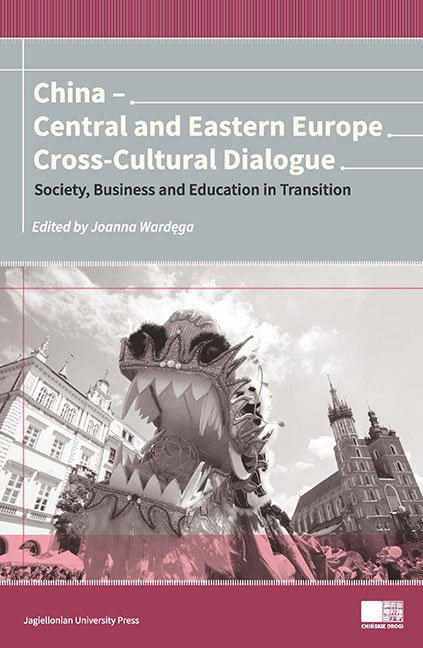Book contents
- Frontmatter
- Contents
- Foreword
- PART I Society and Culture in Transition
- PART TWO Economy and Markets in Transition
- PART THREE Education in Transition
- Opening the Two-Way Fast Lane for China-CEE Cultural Exchange by Equally Valuing the International Promotion of the Chinese Language and the CEE Languages Teaching
- A Contrastive Analysis of Traditional Chinese and Western Teaching Styles – A Case Study
- How Does Learning Style and Teaching Style Jointly Relate to Cultural Intelligence? A Study of Chinese Overseas Students
- Preparation of University Students from Western Cultures for Cooperation with China: Reasons and Methods
- Facing the Challenges of Teaching Chinese through Confucius Classrooms in Slovenian Schools: Current Situation and Prospects
- The Role of the Confucius Institute at Ss. Cyril and Methodius University in Skopje in Promoting the Chinese language, Culture and Business in the Republic of Macedonia
- Education in Transition of China-Based Jesuits from the Austrian Province
- Link in the History: The Development of the Research on Avguštin Hallerstein and its Contemporary Meaning
- Contributors
Education in Transition of China-Based Jesuits from the Austrian Province
from PART THREE - Education in Transition
Published online by Cambridge University Press: 22 December 2017
- Frontmatter
- Contents
- Foreword
- PART I Society and Culture in Transition
- PART TWO Economy and Markets in Transition
- PART THREE Education in Transition
- Opening the Two-Way Fast Lane for China-CEE Cultural Exchange by Equally Valuing the International Promotion of the Chinese Language and the CEE Languages Teaching
- A Contrastive Analysis of Traditional Chinese and Western Teaching Styles – A Case Study
- How Does Learning Style and Teaching Style Jointly Relate to Cultural Intelligence? A Study of Chinese Overseas Students
- Preparation of University Students from Western Cultures for Cooperation with China: Reasons and Methods
- Facing the Challenges of Teaching Chinese through Confucius Classrooms in Slovenian Schools: Current Situation and Prospects
- The Role of the Confucius Institute at Ss. Cyril and Methodius University in Skopje in Promoting the Chinese language, Culture and Business in the Republic of Macedonia
- Education in Transition of China-Based Jesuits from the Austrian Province
- Link in the History: The Development of the Research on Avguštin Hallerstein and its Contemporary Meaning
- Contributors
Summary
The publications and readings of China-based Jesuits’ provide a deep insight into their know-how in light of statistical and historical analysis (Južnič, 2015, p. 126). The Social Network and Academic Genealogy of China-based Jesuit mathematicians and physicists uncovers the way they were educated in Europe. The Academic Genealogy of China-based Jesuits is a comparatively new approach offered in this article. For the time being, the research is limited to the data concerning China-based Jesuits from the Old Society of Jesus in the Austrian and Bohemian Jesuit provinces and to Tyrolean part of the Upper German Jesuit province, which is geographically situated on the territory of modern Austria and Italy. The aim is to get an insight into China-based Jesuits who came from the political unit of Habsburg-hereditary Mid-European lands (Österreichische Erblande), acquired by the Habsburgs in 1278, and from the Lands of the Bohemian Crown, annexed in 1526.
The political borders in those times do not quite match the borders of Jesuit provinces. In a broader sense, the Österreichische Erblande consisted of the Archduchy of Austria (Upper Austria and Lower Austria), Inner Austria, and the County of Tyrol. The Lands of the Bohemian Crown were a separate unit. The modern areas of Österreichische Erblande are the states of Austria, Slovenia, Northwestern Croatia with Istria, and Northeastern Italy. The modern area of the greatest part of the Lands of the Bohemian Crown is the state of Bohemia, but its northern part now belongs to the Southeast Germany and Southwest Poland. The previously independent Crown-lands of Bohemia and the Hungarian Monarchy were both incorporated into the Habsburg Empire in 1526, but Bohemian contributions to the Chinese Jesuit missions were much greater because Jesuits from the Hungarian Kingdom did missionary work in their neighboring Turkish lands. In contrast, there were at least thirty-seven Hungarian and five Romanian Jesuits who successfully worked in China in 20th century. Another contrast is that many Croatian Jesuits from the Old Society worked in the Americas, including Ivan Ratkaj, Ferdinand Konšćak, Ignacije Szentmartony, and Franjo Ksaver Haller.
- Type
- Chapter
- Information
- China - Central and Eastern Europe Cross-Cultural Dialogue Society, Business and Education in Transition , pp. 407 - 432Publisher: Jagiellonian University PressPrint publication year: 2016

